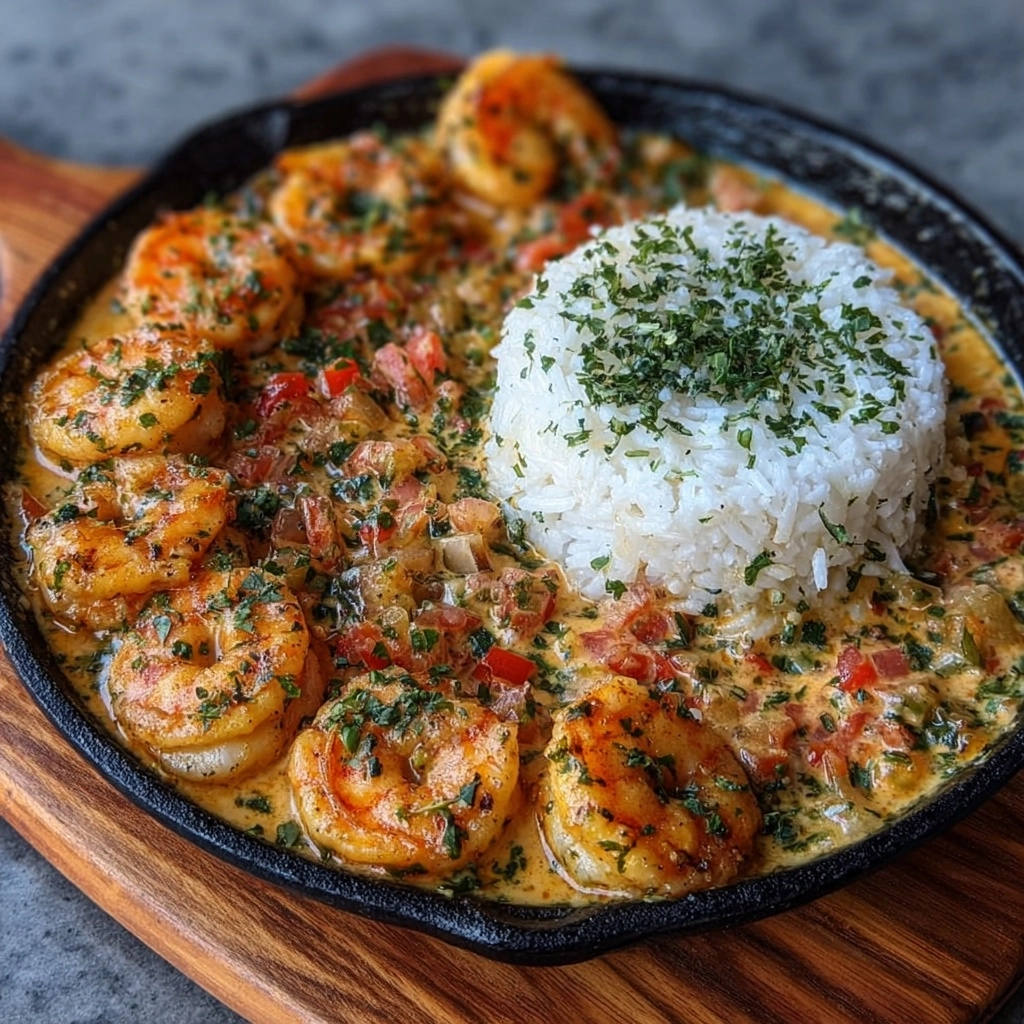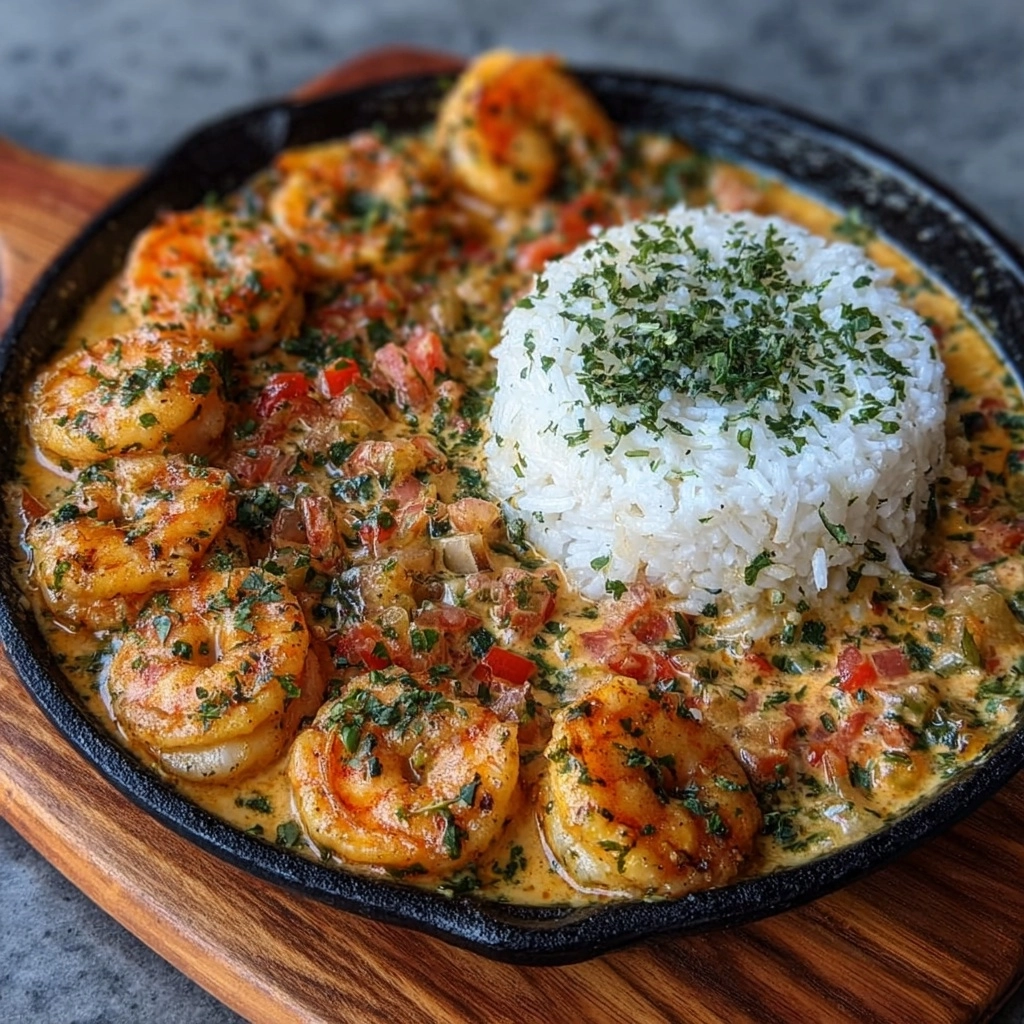If you’re looking for a vibrant dish that bursts with tropical flavors and a touch of spice, Coconut Curry Shrimp is an absolute showstopper. This recipe combines tender, juicy shrimp with a creamy, luscious coconut curry sauce that’s perfectly balanced by zesty lime and fragrant herbs. Whether you’re craving a weeknight dinner with a twist or an impressive dish for guests, Coconut Curry Shrimp delivers on all fronts with its rich complexity, fresh vegetables, and comforting jasmine rice. It’s a delightful mix of sweet, savory, and spicy that brings sunshine to your plate.
Ingredients You’ll Need
The beauty of Coconut Curry Shrimp lies in how simple yet essential each ingredient is. Each one adds a specific burst of flavor, texture, or color that makes the dish vibrant and satisfying. From the creamy coconut milk to the fresh snap peas, every component plays a crucial role.
- Large shrimp (1 lb): Peeled and deveined shrimp cook quickly and absorb the flavors of the curry beautifully.
- Coconut or vegetable oil (2 tbsp): Coconut oil adds a subtle richness that complements the curry’s tropical notes.
- Small onion (1), finely chopped: Builds a sweet and savory base when sautéed gently.
- Garlic (2 cloves), minced: Offers a warm, aromatic punch that wakes up the palate.
- Fresh ginger (1-inch piece), grated: Adds a refreshing, slightly spicy zing to the curry sauce.
- Red or yellow curry paste (2 tbsp): This is where your heat and deep curry flavor come from—adjust to your taste to keep it mild or spicy.
- Coconut milk (1 can, 14 oz): Creates the luxuriously creamy base that ties all the flavors together.
- Red bell pepper (1), sliced: Adds crispness and a pop of color that brightens the dish.
- Snap peas or green beans (1 cup): These vegetables keep a pleasing crunch and bring fresh green notes.
- Fish sauce (1 tbsp): A little umami magic that deepens the savory layers of the curry.
- Lime juice (1 tbsp): Lifts the dish with a bright, citrusy finish that balances the creaminess.
- Sugar or palm sugar (1 tsp): Just enough sweetness to tame the spice and round out the flavor.
- Fresh cilantro, for garnish: Adds a fresh herbal brightness at the very end.
- Cooked jasmine rice, for serving: The perfect fluffy bed to soak up all the delicious curry sauce.
How to Make Coconut Curry Shrimp
Step 1: Cook Aromatics
Start by heating the coconut oil in a large skillet or wok over medium heat. Then add the finely chopped onion, minced garlic, and freshly grated ginger. Sauté these ingredients for about 2 to 3 minutes until they become wonderfully fragrant and translucent. This step lays the fragrant, flavorful foundation for your Coconut Curry Shrimp, coaxing out the natural sweetness of the onion and the zesty notes from the ginger and garlic.
Step 2: Add Curry Paste
Next, stir in your choice of red or yellow curry paste. Cook it gently for one minute so it can fully release its depth of flavor and spice. This moment is key because it allows the curry paste to toast slightly, intensifying the richness and complexity of your sauce before the liquids go in.
Step 3: Simmer with Coconut Milk
Pour in the creamy coconut milk, followed by the fish sauce and sugar. Bring this delicious mixture to a gentle simmer. The coconut milk thins out the paste, creating a silky sauce that envelops every bite with a perfect balance of heat, creaminess, and umami. The fish sauce and sugar help boost savory dimensions while giving a subtle sweetness to counterbalance the spice.
Step 4: Add Vegetables and Shrimp
Now, toss in the sliced red bell pepper and your choice of snap peas or green beans. Let them cook for 2 to 3 minutes until they are tender but still delightfully crisp. Then add your shrimp and simmer everything together for another 3 to 4 minutes until the shrimp turn pink and opaque. This quick cooking keeps the shrimp juicy and tender while adding colorful veggies that lighten and freshen the dish.
Step 5: Finish with Lime and Serve
To finish, stir in freshly squeezed lime juice and sprinkle the dish with chopped cilantro. Serve your luscious Coconut Curry Shrimp hot over steaming jasmine rice so it soaks up every bit of that incredible, creamy curry sauce. The lime adds a zesty brightness that cuts through the richness, while the cilantro brings a fresh herbal note that makes every bite pop.
How to Serve Coconut Curry Shrimp

Garnishes
Fresh cilantro is a must for garnishing Coconut Curry Shrimp—it adds a refreshing burst of herbal flavor and a gorgeous green contrast. You can also sprinkle some thinly sliced red chili or a few toasted coconut flakes for extra texture and visual appeal. A wedge of lime on the side invites guests to add an extra citrusy zing if desired.
Side Dishes
The best side for Coconut Curry Shrimp is fragrant jasmine rice, which perfectly absorbs the rich sauce and balances the spices. For variety, you can serve it with fluffy coconut rice, steamed basmati, or even warm naan bread for scooping. A simple cucumber salad or lightly pickled vegetables provide a crisp, cooling counterpoint that refreshes the palate.
Creative Ways to Present
For a fun twist, serve Coconut Curry Shrimp in coconut halves to enhance the tropical vibe visually and experientially. Another idea is to pile the shrimp curry over crispy rice noodles or roasted sweet potatoes for a cozy but elegant take. A colorful bowl with bright veggies and your choice of greens makes it an Instagram-worthy meal that tastes as good as it looks.
Make Ahead and Storage
Storing Leftovers
Once cooled, store any leftover Coconut Curry Shrimp in an airtight container in the refrigerator. It will stay fresh for up to 3 days, making it a wonderful next-day meal or lunch option that tastes just as vibrant.
Freezing
You can freeze Coconut Curry Shrimp, but be mindful that the shrimp texture may soften slightly after thawing. Transfer the curry to a freezer-safe container and freeze for up to 2 months. To enjoy later, thaw overnight in the fridge before reheating gently on the stove.
Reheating
Reheat your Coconut Curry Shrimp slowly on the stovetop over low to medium heat, stirring occasionally to prevent the sauce from separating. If the curry thickens too much, add a splash of water or coconut milk to restore the creamy consistency. Avoid microwaving if possible, as gentle reheating preserves the flavors and texture best.
FAQs
Can I use frozen shrimp for Coconut Curry Shrimp?
Yes, frozen shrimp work perfectly as long as they are fully thawed and patted dry before cooking. This helps maintain the dish’s texture and ensures your curry stays sauce-rich instead of watery.
What kind of curry paste should I choose?
Red or yellow curry paste are both excellent choices. Red curry is a little spicier and bolder, while yellow curry tends to be milder and more aromatic. Pick based on your heat preference and the flavor profile you love most.
Can I make this dish vegetarian?
Absolutely! Swap the shrimp for tofu or a mix of your favorite vegetables, and replace fish sauce with soy sauce or tamari. The coconut curry base will still be delightfully flavorful and creamy.
Is Coconut Curry Shrimp spicy?
The level of spice depends mostly on the curry paste you use. Adjust the amount of paste to suit your preference, adding less for milder flavor or more if you enjoy a spicy kick.
What can I substitute if I don’t have fish sauce?
You can use soy sauce or tamari as an alternative for fish sauce. While it won’t deliver the exact same umami depth, it still adds a savory punch that complements the curry beautifully.
Final Thoughts
This Coconut Curry Shrimp recipe is a personal favorite that never fails to impress. It’s quick enough for busy nights yet luxurious enough to share with friends and family. The creamy, spicy, and fresh flavors create a harmonious, delicious bowl that feels like a warm hug on a plate. I wholeheartedly encourage you to give it a try—you might just find your new go-to comfort dish!




Your email address will not be published. Required fields are marked *